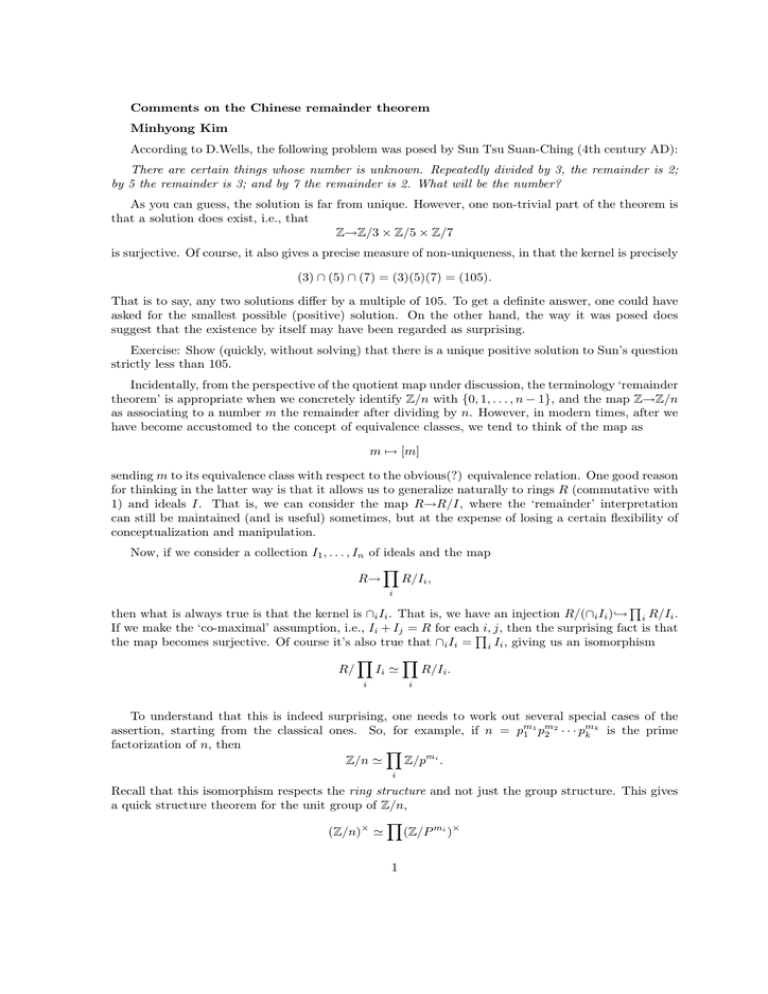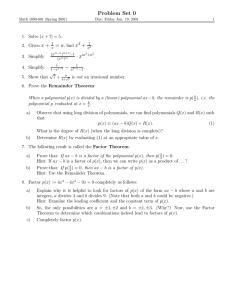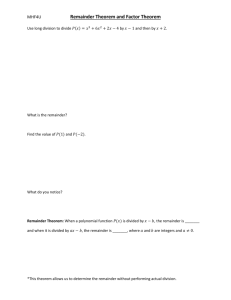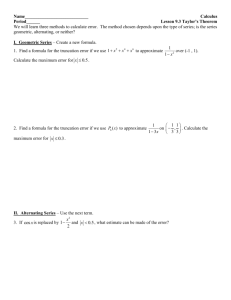Comments on the Chinese remainder theorem Minhyong Kim
advertisement

Comments on the Chinese remainder theorem
Minhyong Kim
According to D.Wells, the following problem was posed by Sun Tsu Suan-Ching (4th century AD):
There are certain things whose number is unknown. Repeatedly divided by 3, the remainder is 2;
by 5 the remainder is 3; and by 7 the remainder is 2. What will be the number?
As you can guess, the solution is far from unique. However, one non-trivial part of the theorem is
that a solution does exist, i.e., that
Z→Z/3 × Z/5 × Z/7
is surjective. Of course, it also gives a precise measure of non-uniqueness, in that the kernel is precisely
(3) ∩ (5) ∩ (7) = (3)(5)(7) = (105).
That is to say, any two solutions differ by a multiple of 105. To get a definite answer, one could have
asked for the smallest possible (positive) solution. On the other hand, the way it was posed does
suggest that the existence by itself may have been regarded as surprising.
Exercise: Show (quickly, without solving) that there is a unique positive solution to Sun’s question
strictly less than 105.
Incidentally, from the perspective of the quotient map under discussion, the terminology ‘remainder
theorem’ is appropriate when we concretely identify Z/n with {0, 1, . . . , n − 1}, and the map Z→Z/n
as associating to a number m the remainder after dividing by n. However, in modern times, after we
have become accustomed to the concept of equivalence classes, we tend to think of the map as
m 7→ [m]
sending m to its equivalence class with respect to the obvious(?) equivalence relation. One good reason
for thinking in the latter way is that it allows us to generalize naturally to rings R (commutative with
1) and ideals I. That is, we can consider the map R→R/I, where the ‘remainder’ interpretation
can still be maintained (and is useful) sometimes, but at the expense of losing a certain flexibility of
conceptualization and manipulation.
Now, if we consider a collection I1 , . . . , In of ideals and the map
Y
R→
R/Ii ,
i
Q
then what is always true is that the kernel is ∩i Ii . That is, we have an injection R/(∩i Ii ),→ i R/Ii .
If we make the ‘co-maximal’ assumption, i.e., Ii + Ij = R for eachQi, j, then the surprising fact is that
the map becomes surjective. Of course it’s also true that ∩i Ii = i Ii , giving us an isomorphism
Y
Y
R/
Ii '
R/Ii .
i
i
To understand that this is indeed surprising, one needs to work out several special cases of the
mk
1 m2
assertion, starting from the classical ones. So, for example, if n = pm
is the prime
1 p2 · · · pk
factorization of n, then
Y
Z/n '
Z/pmi .
i
Recall that this isomorphism respects the ring structure and not just the group structure. This gives
a quick structure theorem for the unit group of Z/n,
Y
(Z/n)× '
(Z/P mi )×
1
For example,
(Z/35)× ' (Z/7)× × (Z/5)× ' Z/6 × Z/4
In his regard, it is useful to recall that the structure of the group of units can be a rather tricky
problem, starting from the data of the ring. For example,
√
(Z[ 6])× ' Z × Z/2
but this fact includes a rather tricky assertion about the solutions of the Diophantine equation
x2 − 6y 2 = ±1.
(What is this assertion?) Sometimes the unit group can be related to the ring in a natural way, but
with a rather different flavor: For example,
Mn (C)× = GLn (C)
or
(Z)× ' Z/2.
In any case, the remainder theorem resolves the issue rather simply for these finite rings.
I like to consider the case of polynomial rings. In one variable, the situation is very similar to Z,
as emphasized many times in the lectures. In C[x], for example, (f (x)) and (g(z)) are co-maximal
exactly when they have no common primes factors. The prime factors in this ring are exactly (x − a)
for a ∈ C. In this case, however, there is also a ‘geometric interpretation’ that they are co-maximal
exactly when f and g have no common zeros on the complex plane.
The theorem says that
d
Y
C[x]→
C[x]/(x − ai )
i=1
is surjective, in so far as the ai are distinct. This is true regardless of the cardinality d. Now we have
an isomorphism C[x]/(x − ai ) ' C induced by the evaluation map f 7→ f (ai ). So we interpret the
theorem as the statement that we can specify arbitrary values c1 , . . . , cd at the d points a1 , . . . , ad ,
and there will be a single polynomial f satisfying f (ai ) = ci for all i. Since the kernel of the map
is ((x − a1 ) · · · (x − ad )) and hence generated by a polynomial of degree d, we see that any solution
can replaced by its remainder after dividing by this generator. Hence, there is always a solution of
degree ≤ d − 1. It is important to learn the algorithm for actually producing solutions, in Z or in C[x].
But let me outline one approach that will bring up an interesting connection. By the information we
have gained already, we can take a polynomial f (x) = b0 + b1 x + · · · + bd−1 xd−1 with undetermined
coefficients, and then solve for the bi so that the conditions are satisfied. But these conditions are
b0 + b1 a1 + · · · + bd−1 ad−1
= c1
1
b0 + b1 a2 + · · · + bd−1 ad−1
= c2
2
..
.
b0 + b1 ad + · · · + bd−1 ad−1
= cd
d
or
Ab = c
where b and c are column vectors formed by the fixed
matrix
1 a1 · · ·
1 a2 · · ·
..
.
1 ad · · ·
2
ci and unknown bi respectively, while A is the
ad−1
1
ad−1
2
ad−1
d
That is, what we are required to solve is in fact a linear system. Since the theorem says we can always
solve for b regardless of what c is, this implies that the d × d matrix A has full rank, and hence, is
invertible. You should know the classical formula from linear algebra, that says
Y
det A =
(ai − aj ),
i>j
a so-called Vandermonde determinant. This also gives the invertibility, via a precise expression. But
it is interesting that just abstract algebra suffices for just the invertibility part. (In the construction
of codes, being able to write down such invertible matrices with flexibility in the ai ’s is important.)
The remainder theorem might thus be expected to comprise many other apparently different results
in linear or non-linear algebra as special cases, but we will not dwell on working out more of these.
However, you should consider the case of the ideals (x − a1 )n1 , · · · , (x − ad )nd which are still co-prime
when the ai are distinct. In this case, we are saying that not just values, but a finite collection of
derivatives can be specified as each point. There may be an invertible matrix underlying this assertion
as well. Can you work it out?
The several variable case is also interesting. Inside C[x, y], take I = (x − 1, y) and J = (x). Then
I + J = (x − 1, x, y) contains 1 and is therefore the unit ideal. We know then that
C[x, y]→[C[x, y]/(x − 1, y)] × [C[x, y]/(x)]
is surjective. But C[x, y]/(x − 1, y) ' C via evaluation at (1, 0) while C[x, y]/(x) ' C[y] via f (x, y) 7→
f (0, y). Thus, we are allowed to specify any value c at (1, 0) and any polynomial g(y). Then there
exists f (x, y) such that f (1, 0) = c and f (0, y) = g(y). It is harder to visualize the co-maximal
condition in two variables. For the maximal ideals (x − a, y − b) and (x − c, y − d), co-maximality
is easily seen to be equivalent to (a, b) 6= (c, d) as pairs. This is an instance of the general fact that
two maximal ideals are co-maximal iff they are distinct (Why?). You are invited also to try a finite
collection of ideals of the form
(x − a1 , y − b1 )n1 , · · · , (x − ad , y − bd )nd
corresponding to distinct points (ai , bi ) and work out the interpretation of the Chinese remainder
theorem in terms of pre-specified partial derivatives at those points. It seems you should get some
interesting non-vanishing determinants.
In arbitrary dimensions, I would like to relate the remainder theorem to our discussion about ideals
and spaces. That is recall that to an ideal I in C[x] = C[x1 , . . . , xn ], we associated its zero set Z(I).
Now it is a fact that I + J = C[x] if and only if Z(I) ∩ Z(J) = φ. However, Z(I) ∩ Z(J) = Z(I + J).
(By the way, what is Z(I ∩ J)? What about Z(IJ)?) So this is merely the statement that an ideal I
is the unit ideal iff Z(I) = φ. Note that one direction is easy. But the converse is a rather difficult
theorem called Hilbert’s Nullstellensatz. In any case, we get the interpretation of the co-maximal
property as the disjointness of the associated spaces. Meanwhile, recall our interpretation of C[x]/I
as the ring of algebraic functions on Z(I). Of course we think of C[x] itself as the algebraic functions
on the ambient space Cn . So now we restate the remainder theorem in a particularly natural geometric
form: pre-specify any algebraic functions on fI on Z(I) and fJ on Z(J). Then as long as these spaces
are disjoint, there exists a function f on the ambient space that restricts to fI and fJ on Z(I) and
Z(J), respectively. There is, of course, the stronger result involving any finite collection of disjoint
spaces Z(Ii ). In this generality, solving for the function f effectively in the input data in a way
analogous to the single variable case (or the Euclidean algorithm in Z) involves rather recent research
in computational algebra, and goes by the name of ‘effective nullstellensatz.’
To see how well the geometric intuition works, consider what happens if the zero sets are not
disjoint. Of course in that case, we have no right to specify the functions on Z(I) and Z(J) arbitrarily.
After all, any restriction from the ambient space would yield two functions fI and fJ that agree on
the intersection Z(I) ∩ Z(J). So let us try to build this condition into a theorem. That is we would
like
3
Given fI on Z(I) and fJ on Z(J) such that fI |Z(I) ∩ Z(J) = fJ |Z(I) ∩ Z(J), there exists an f
on the ambient space restricting to fI and fJ .
Is this true with our interpretation of algebraic functions? Well recall that Z(I)∩Z(J) = Z(I +J).
So the functions on the intersection are exactly C[x]/(I + J). Then we are requiring that fI and
fJ map to the same element in C[x]/(I + J) under the natural maps C[x]/I→C[x]/(I + J) and
C[x]/J→C[x]/(I + J). (By the way, have you noticed that such natural projection maps to quotient
rings correspond to restriction of functions?)
Put differently, we would like to have an exact sequence:
C[x] −→ C[x]/I × C[x]/J −→ C[x]/(I + J)
where the last map takes (fI , fJ ) to the class [fI ]−[fJ ]. Recall that exactness here just means that the
kernel of the second map exactly equals the image of the first map. In the usual remainder theorem,
the last ring is zero, so the exactness amounts to a surjectivity. This general statement is in fact true!
Prove it yourself. It is actually very easy. And then formulate the correct statement with several
ideals. Finally, reflect on how geometric intuition has led us to a very natural generalization of the
remainder theorem.
What happens if you now apply this generalization to Z? Anything interesting? Consider the
ideals (6) and (10), for example. Is there a number that gives you remainder 5 when divided by 6 and
4 when divided by 10? What about 2 and 5? 3 and 5?
Another fun ring to test your skills on is Z[x] which should roughly behave like C[x, y]. Look for
some co-maximal ideals and formulate concrete instances of the Chinese remainder theorem in this
ring.
4





